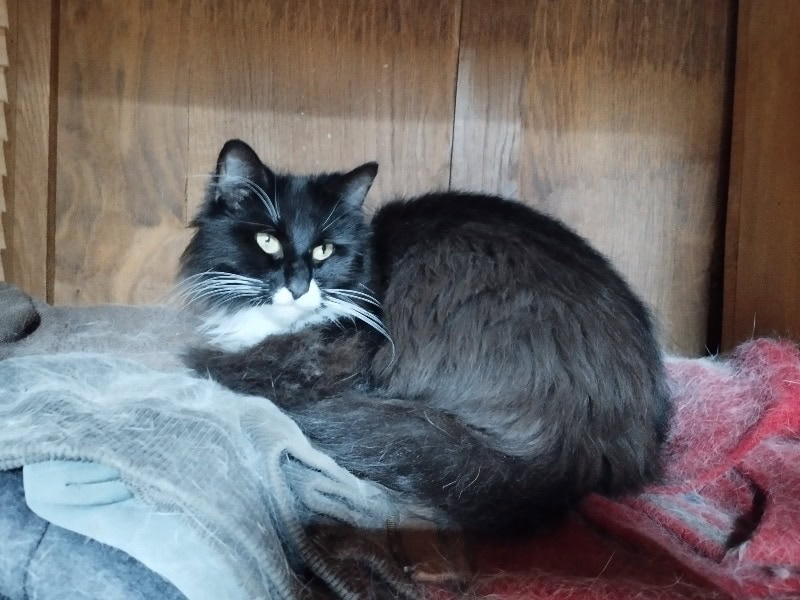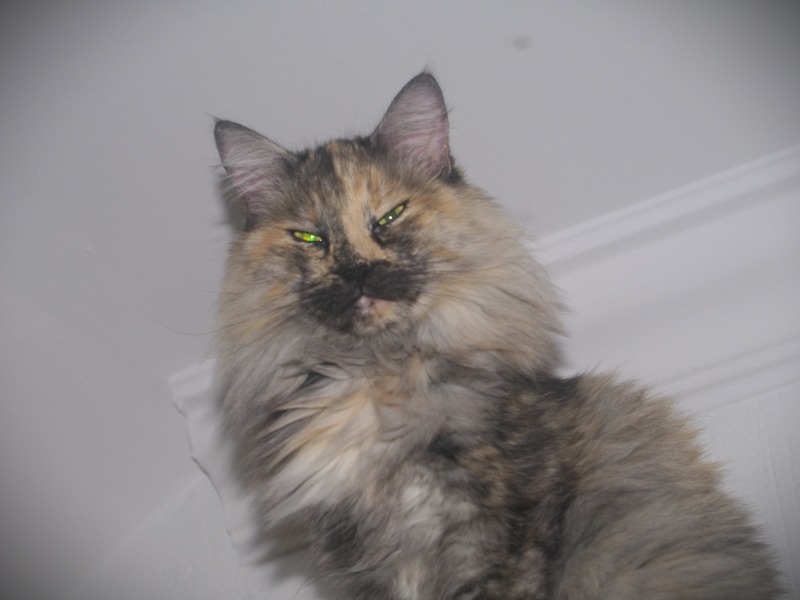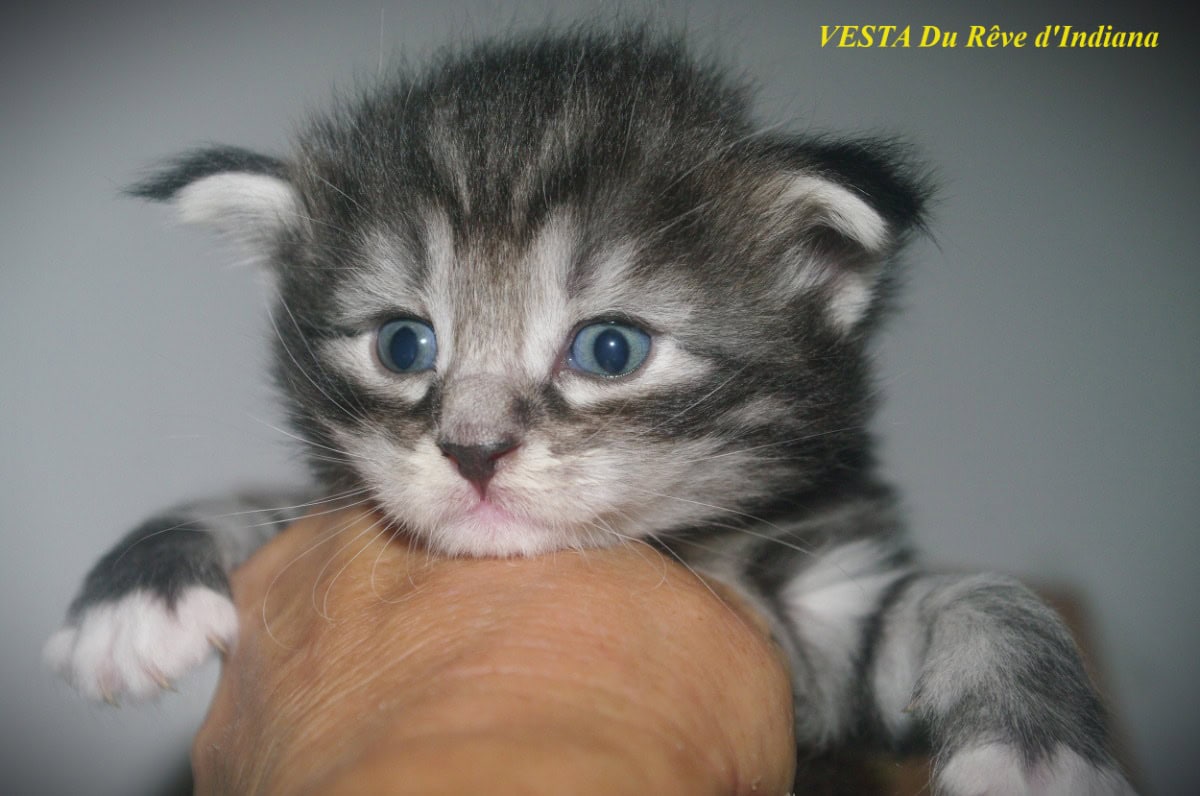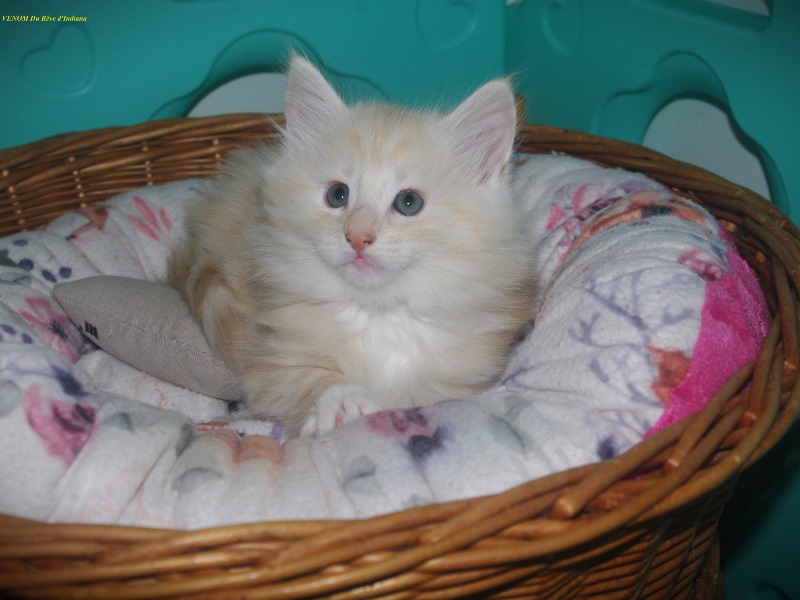Norwegian forest cat
Autres noms : Norsk skogatt, Forest cat, Norwegian cats
Discover the Norwegian Forest Cat, a robust breed with a dense, waterproof coat, perfect for facing cold climates. Friendly, intelligent, and independent, this loyal companion charms with its majestic appearance and playful nature. Ideal for families and active households!
Awareness of acquiring an animal
Adoption and breeding of cats should always be guided by a sincere attachment to the animal and an understanding of its specific needs. Whether for leisure or passion, it is essential to provide a safe, enriching, and suitable environment. Avoid any impulsive acquisition that could harm their well-being. Cats require attention, regular healthcare, and a secure space. Commit to providing them with a quality life by being a conscientious and informed owner or breeder.
To learn more about animal welfare, we invite you to consult our FAQ by clicking the button below:
Origins and history
The Norwegian Forest Cat finds its origins in the dense, cold forests of Norway, where it evolved naturally to adapt to the harsh climatic conditions. Its ancestors are thought to have been wild cats brought by the Vikings, who then managed to acclimatize to the Nordic environment. It is likely that these cats interbred with domestic cats over the centuries, developing a robust breed well-suited to life in the wild.
During the 19th century, interest in this breed increased, particularly due to their usefulness on farms for controlling rodent populations. Breeders began to select them for their physical characteristics, such as their thick, water-resistant fur, as well as for their affectionate nature.
The official recognition of the breed occurred in the 20th century, with cat associations working to promote and protect it. Today, the Norwegian Forest Cat is appreciated not only for its beauty but also for its friendly and sociable temperament, making it a beloved companion in many households around the world.
Physical characteristics
The Norwegian Forest Cat is an imposing and majestic feline, known for its size and robustness. Males are generally larger than females, weighing between 5 and 9 kg, while females weigh between 3.5 and 7 kg. This breed is also famous for its well-developed musculature and elongated body, giving it a powerful and agile appearance.
Its coat is one of its most remarkable features. It is dense, long, and water-resistant, protecting the cat from the elements. This fur is particularly thick around the neck and shoulders, forming a sort of ruff. Coat colors vary significantly, ranging from solid hues to tabby patterns and bi-color combinations. The fur on the tail is also lush, enhancing the image of a wild and elegant animal.
The eyes, almond-shaped, are typically green, golden, or copper, expressing great intelligence. The ears, wide at the base and slightly pointed, are often adorned with tufts of fur, accentuating the wild aspect of this breed. In summary, the physical traits of the Norwegian Forest Cat contribute to its mysterious charm and majestic appearance.
Character
The Norwegian Forest Cat is a feline with a unique and fascinating character. Firstly, it is often described as affectionate and social. This breed likes to form strong bonds with its owners and can be very cuddly, seeking human companionship and adapting well to family life. Its friendly personality also makes it tolerant of children and even other animals, making it an ideal companion for lively households.
Moreover, the Norwegian Forest Cat possesses great independence. While it enjoys human interaction, it is also capable of spending time alone without experiencing anxiety. This trait makes it quite an autonomous animal, loving to explore its environment and hunt, even indoors. Its natural curiosity drives it to venture out and observe its surroundings, which can make it both fearless and adventurous.
Finally, it's worth noting that this breed is characterized by its intelligent and playful nature. Norwegian Forest Cats thrive when they are mentally and physically stimulated, and they enjoy interactive play. Their sharp minds allow them to learn quickly and adapt to various environments, making them delightful and adaptable pets. In summary, this feline combines affection, independence, and intelligence, making it an ideal companion for various types of households.
Life expectancy
The life expectancy of Norwegian Forest cats generally ranges between 12 and 16 years. This duration can vary depending on various factors, including genetics, healthcare, environment, and the lifestyle of each animal. Cats that benefit from a balanced diet, regular exercise, and veterinary visits are often healthier and can live longer.
Their physical characteristics, such as their thick fur and sturdy paws, make them particularly well-suited to cold climates. However, like all cat breeds, they have predispositions to certain diseases. Common conditions may include heart or kidney problems, underscoring the importance of regular veterinary check-ups.
Finally, the socialization and environment in which these cats live also play a crucial role in their longevity. Those that live indoors, protected from outside dangers, tend to have a higher life expectancy than those that roam outside. It is essential to provide a safe and stimulating living environment to ensure their well-being and maximize their lifespan.
Exercise and activity needs
The Norwegian Forest Cat is an active and dynamic breed that requires a good level of exercise and activity. These felines, with their great agility and endurance, love to climb, jump, and explore their environment. To meet their needs, it is essential to provide them with a spacious living area where they can move freely. A well-furnished apartment with shelves, scratching posts, and play areas will encourage their natural instincts for climbing and exploration.
Human interaction also plays a significant role in the well-being of these cats. They enjoy stimulating games, such as those involving feathers or lasers, which allow them to expend energy both physically and mentally. Daily play sessions of about 20 to 30 minutes can contribute to their health and happiness. Additionally, the introduction of interactive toys and food puzzles can help stimulate their intellect while satisfying their innate curiosity.
Finally, it’s important to note that these felines require constant mental stimulation. Enriching their environment by adding new toys or small challenges can help prevent boredom and avoid undesirable behaviors. In summary, by providing a rich and varied environment while ensuring their physical and mental activity, we can guarantee a fulfilling life for these magnificent cats.
Recommended diet
The Norwegian Forest Cat is a robust and active breed, which requires a diet tailored to its energy and nutritional needs. To ensure their well-being, it is crucial to prioritize a diet rich in high-quality proteins. Animal proteins, such as those from meat, fish, and eggs, should make up the majority of their diet. These nutrients are essential for supporting strong muscles and the overall health of the animal.
Additionally, fats play a vital role in the diet of these felines. Omega-3 and omega-6 fatty acids, often found in fish oils, are important for skin and coat health, especially considering the density of their fur. It is also advisable to include carbohydrates in moderate amounts, coming from sources like vegetables and grains, which can provide energy while avoiding excesses that could lead to weight issues.
Vitamins and minerals, on the other hand, are indispensable for ensuring the proper functioning of metabolism. A complete and balanced food, often offered in the form of kibble or specially formulated wet food for active cats, can help meet these needs. Finally, constant access to fresh water is essential to maintain good hydration and promote healthy digestion.
Training and obedience
The education and training of Norwegian Forest cats require a patient and positive approach. Due to their curious nature and intelligence, they respond well to training methods based on positive reinforcement. Using treats and praise when the cat behaves well encourages desired behaviors.
These cats are generally sociable and enjoy interacting with humans and other animals. This underscores the importance of socializing the cat from a young age. Exposing the cat to various people, animals, and environments helps develop its confidence and adaptability.
It is crucial to stimulate their minds. Norwegian Forest cats enjoy interactive games and challenges. Puzzle toys or regular play sessions help channel their energy constructively. This also prevents boredom, which can lead to undesirable behaviors.
Finally, establishing routines and clear boundaries is fundamental for discipline. These cats respond better when they understand what is expected of them. By integrating these principles into their education, one fosters a harmonious and enriching environment for these felines.
Behavior with children
The behavior of Norwegian Forest Cats with children is generally positive. These cats, known for their friendly and sociable nature, often develop a good relationship with younger ones. Their gentle temperament and curiosity make them excellent companions for children. They tend to be playful and enjoy engaging in fun activities, which promotes pleasant and enriching interactions.
However, it is essential to teach children how to interact properly with these animals. Cats are sensitive and can become fearful if handled too roughly. Teaching children to approach cats calmly and to respect their personal space helps establish a healthy and harmonious relationship.
Moreover, the independent nature of this breed allows them to retreat to a quiet corner when they feel the need. Therefore, it is important to provide cats with a place where they can feel safe, especially when children are excited. By respecting these points, the coexistence between Norwegian Forest Cats and children can be extremely rewarding for the whole family.
Compatibility with Other Animals
The Norwegian Forest Cat is known for its balanced and social temperament, which generally makes it compatible with other pets. Their friendly nature promotes positive interactions with dogs, other cats, and even some rodents, as long as the meetings are supervised.
This breed, which has a solid constitution and a natural curiosity, can easily adapt to an environment where multiple species coexist. Their intelligence enables them to quickly understand group dynamics. However, it is recommended to introduce new animals gradually to minimize stress and encourage harmonious relationships.
It is also important to consider the individual character of each animal, as even within the same breed, personalities can vary. A well-socialized Norwegian Forest Cat, which has had positive experiences with other animals, is likely to get along with them, whereas a less exposed individual might be more timid or territorial.
In summary, introducing a Norwegian Forest Cat into a household with other animals can be successful, provided that a patient and attentive approach is adopted.
Grooming needs
The Norwegian Forest Cat, with its thick fur and dense undercoat, requires regular maintenance to keep its health and beauty. Grooming should be done at least once to twice a week. This helps remove dead hair and prevents the formation of tangles, especially during shedding periods in spring and autumn.
In addition to brushing, it is essential to monitor the ears and eyes. The ears should be cleaned regularly to prevent wax buildup or infections, and the eyes may need gentle wiping if tear stains occur. Checking the claws is also crucial; it is recommended to trim them periodically to prevent them from becoming too long.
Finally, special attention to diet and hydration is essential for the overall health of this cat. A balanced diet not only contributes to a healthy coat but also to optimal well-being. These maintenance practices help preserve the beauty and playful character of this unique breed.
Health
The Norwegian Forest Cat is a robust breed well-suited to harsh climatic conditions. Its physical constitution provides good resistance to diseases. However, like any breed, there are certain health concerns. The most common genetic issues include hypertrophic cardiomyopathy, a heart disease that can affect cats of any age. Regular screenings at the veterinarian can help monitor this condition.
Another important aspect of this breed's health is the need for good dental hygiene. Cats can be prone to dental problems, and regular dental care, such as brushing and veterinary visits, is recommended to prevent periodontal disease.
Finally, the predisposition to obesity can also impact their health. A balanced diet and regular exercise are essential to maintaining a healthy weight. By ensuring their physical well-being and having frequent veterinary visits, one can prolong the life and ensure the health of the Norwegian Forest Cat.
Environment and habitat
The Norwegian Forest Cat is a feline breed originating from the dense and wild forests of Norway, an environment that has significantly influenced its physical and behavioral characteristics. Its adaptation to a harsh climate is reflected in its thick, water-repellent coat that protects against moisture and cold. This coat consists of two layers: a dense undercoat and a longer outer layer, enabling it to withstand inclement weather.
This animal typically lives in wooded areas where it can climb trees to hunt or escape predators. Its natural habitat is rich in prey, such as rodents and birds, ensuring a varied diet. The forests also provide nesting sites and shelter to protect it from the elements and potential threats.
The Norwegian Forest Cat is distinguished by its friendly and sociable temperament. In a domestic environment, it retains its hunting instincts while adapting to family life. This cat needs space to thrive, and a stimulating environment, such as access to trees or high surfaces, is beneficial for fulfilling its needs for exploration and exercise.
Name ideas
Choosing a name for a breed of cats, such as the Norwegian Forest Cat, can be a creative and enjoyable process. It is important to consider certain characteristics of this breed, such as its origin, appearance, and temperament. Norwegian forests are often associated with natural landscapes and elements of nature. A good name should reflect these qualities while being easily pronounceable and memorable.
It is also useful to consider themes like mythology, Scandinavian culture, or even names of iconic places in Norway, which can add a touch of authenticity. Names can be chosen based on physical traits, like fur, or personality aspects, such as curiosity or the independence of these cats.
Here are about fifteen name suggestions: Fjord, Viking, Rune, Svalbard, Aurora, Norræna, Ice, Forest, Winter, Freya, Thor, Pinecone, Lapland, Star, Selkie. These names evoke Norway's majestic landscapes, its rich culture, and the unique character of this cat breed, offering a variety of options to best represent its essence.
Average purchase price
The price of a Norwegian Forest cat can vary significantly depending on several factors. On average, the cost to acquire a kitten generally ranges between 800 and 1,500 euros. This price can be influenced by the breeder's reputation, the cat's lineage, as well as its adherence to the breed standards. Reputable breeders often invest in the health and well-being of their animals, which can justify a higher price.
Additionally, extra expenses should also be taken into account when purchasing. Vaccinations, spaying or neutering, and basic supplies (litter, food, toys) can represent a significant additional cost. For example, it is common for initial veterinary care, such as vaccinations and health checks, to be included in the purchase price or billed separately, which can increase the initial budget.
Finally, it is wise to consider the long-term maintenance costs, including food, regular veterinary care, and grooming, which can also affect your finances. Thus, it is essential to evaluate these different aspects before acquiring a cat of this breed.
Expenses
Owning a Norwegian Forest Cat involves various monthly expenses that are essential to consider. First of all, food is one of the main costs. A good quality diet can range from 30 to 60 euros per month. Cats of this breed require protein-rich kibble, which can lead to somewhat higher costs than for other breeds.
Next, you should think about veterinary expenses. Regular check-ups, vaccinations, and preventive treatments, such as deworming and antiparasitics, can amount to around 15 to 40 euros per month when annualized. In case of illness or injury, the costs can be significantly higher, so pet health insurance might be an additional expense, estimated at between 15 and 25 euros monthly.
Finally, it is important to budget for accessories and toys. A budget of 10 to 20 euros per month can be reasonable for maintaining their environment. In summary, for a Norwegian Forest Cat, a total monthly budget of 70 to 145 euros seems realistic.
Destination and usage
The Norwegian Forest Cat is a prized breed for its qualities as a companion. Originating from the Nordic regions, this cat is distinguished by its gentle and affectionate nature, making it an excellent choice for families. Its sociable personality allows it to thrive both with children and other pets. With a calm and balanced personality, it easily adapts to various environments, whether it's a lively house or a quiet apartment.
Furthermore, this cat is known for its natural curiosity. Its playful spirit drives it to explore its surroundings, which can delight owners seeking an interactive companion. Its climbing abilities make it an excellent climber, often prompting owners to create high play areas, thus promoting its well-being.
In terms of maintenance, the Norwegian Forest Cat requires regular brushing due to its thick coat. This activity can become a bonding moment between the animal and its owner, strengthening their emotional connection. In summary, this cat is an ideal choice for those looking for a loyal and lively pet.
Legislation and regulation
The legislation and regulations concerning Norwegian Forest Cats vary significantly around the world, reflecting the cultural and legal differences of each country. In some European countries, such as Norway and Sweden, specific regulations exist to protect and promote this breed. Feline associations ensure the authenticity of bloodlines and responsible breeding, guaranteeing that breed standards are adhered to.
In contrast, other countries may have less stringent rules regarding breeding. This can lead to irresponsible breeding practices, endangering the health and well-being of the animals. In certain regions, there is no official recognition of this breed, complicating the regulation of breeders and potentially leading to abuses.
It is also crucial to note that some national legislations address the issue of companion animals in general, incorporating measures on animal welfare, responsible breeding, and sterilization. These laws can indirectly affect practices related to Norwegian Forest Cats by allowing for better protection and a framework for breeders.
Official recognition
The Norwegian Forest Cat is a breed that has generated significant interest in the feline world, both for its majestic appearance and its sociable character. The official recognition of this breed varies by country and feline organizations.
In Nordic countries, particularly Norway, the breed enjoys official recognition. Dedicated clubs focus on promoting and developing this breed, ensuring compliance with quality standards. Additionally, events such as cat shows allow breeders to showcase their animals and enhance the breed's popularity.
In Europe, organizations like the International Cat Federation have also recognized this breed, facilitating broader dissemination among member countries. In other regions, such as North America, recognition is also present but may vary by cat societies. Acceptance by these different organizations contributes to establishing standards, thus encouraging an ethical approach to breeding.
In summary, the Norwegian Forest Cat is widely recognized internationally, although the degree of recognition may differ by region. This recognition promotes the preservation of the breed's unique characteristics as well as its integration into the global feline culture.
Pedigrees
To obtain a pedigree for a Norwegian Forest cat, several cat registries and clubs are recognized. These organizations play an important role in promoting, protecting, and recognizing breed standards. The main international registry is the *Fédération Internationale Féline (FIFe)*, which offers certificates and pedigrees for purebred cats.
In France, the *Société Centrale Féline (SCF)* is one of the primary organizations that manage pedigrees. The SCF collaborates with various breed clubs to ensure compliance with the standards of the Norwegian Forest cat. In other countries, the *Cat Fanciers' Association (CFA)* and the *International Cat Association (TICA)* are also viable options for registering these cats.
It is recommended for breeders and owners to join specialized clubs such as the *L'Association Française des Amateurs de Chats Norvégiens*, which not only provides advice on breeding but also organizes events to showcase their cats, thus promoting the recognition of the breed. These organizations ensure adherence to breed standards and guarantee genealogical traceability, which is essential for maintaining the health and quality of the lineage of these magnificent felines.
Prohibitions
The Norwegian Forest Cat is a feline breed appreciated for its beauty and characteristic features. However, certain regulations vary from country to country regarding the ownership and breeding of this breed. In several European countries, animal breeding laws include strict requirements concerning the living conditions, health, and welfare of the animals.
In regions like Northern Europe, there is generally a strong acceptance of this breed, but restrictions may arise if animal welfare standards are not met by breeders. Authorities may impose checks to ensure that breeding practices do not jeopardize the health of the animals.
Outside of Europe, the laws may be less permissive. Some countries may prohibit the establishment of breeding facilities for this breed due to concerns related to the importation of animals, diseases, or strict regulations on exotic animals.
In summary, the legal situation regarding the Norwegian Forest Cat heavily depends on the country, resulting in significant variations in how this breed is perceived and regulated. Potential owners are thus encouraged to inquire about local laws before acquiring this type of feline.
Breeders of Norwegian forest cat
Want to see more breeders of Norwegian forest cat?
Check out the page of our directory listing all breeders of Norwegian forest catClassified Ads of Norwegian forest cat
Want to see more ads of Norwegian forest cat?
Check out the page listing all the ads of Norwegian forest catBreed clubs of norwegian forest cat
No of norwegian forest cat breed clubs are currently registered on Preeders.
If you would like to highlight your breed club, sign up for free now and be the first to appear on this page.







